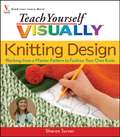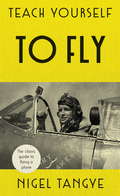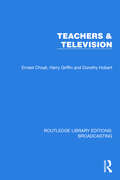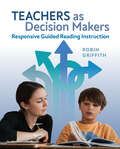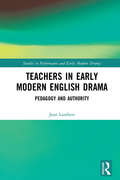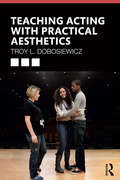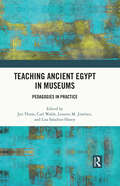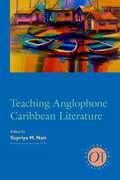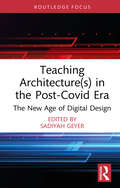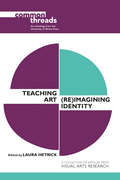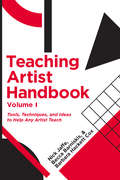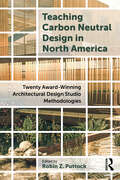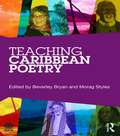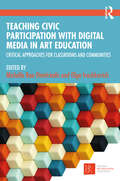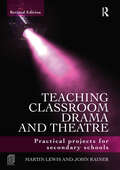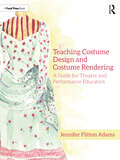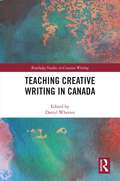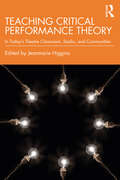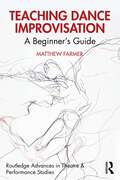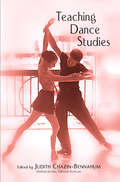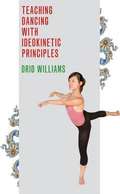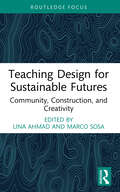- Table View
- List View
Teach Yourself Visually: Knitting Design
by Sharon TurnerThere are lots of stylish knitting patterns out there, but sometimes you want to do your own thing. Maybe you've found a yarn that would make a beautiful hat, and all you need are basic directions for shaping. Or maybe you've had your eye on a cute sweater in a store window and know that you can make a better version yourself-if you could only figure out the measurements. This handy guide demystifies all that knitting math and shows you how to knit custom-fitted, one-of-a-kind fashions that express your style. Master patterns for hats, sweaters, scarves, shawls, bags, mittens, vests, and socks lay out the basic construction for each item in a range of sizes; you choose the yarn and decide which modifications and customizations you want to make. Precise master patterns show you all the steps involved in constructing handknits Master patterns give instructions for multiple sizes and gauges A number of shaping, edgings, and stitch patterns accompany each master pattern Helpful tips provide additional guidance Tables take the work out of knitting math Step-by-step instructions accompany each photo Color photos, illustrations, and diagrams demonstrate important concepts
Teach Yourself to Fly: The classic guide to flying a plane
by Nigel TangyeFirst published in 1938, Teach Yourself To Fly was not only one of the very first Teach Yourself books to be published but the first to actually change the world. It was used on the eve of the second world war to prepare pilot recruits and conscripts before they were called for service, and as such it was read religiously by thousands of young men, some as young as 17, and directly impacted on the British war effort.This beautiful new printing of the book captures all of the feelings of that extraordinary time - it's nostalgic, understated, inspiring and very British indeed, warning young pilots, amongst other things, not to feel 'too discouraged' in the event of a crash landing.Technology has changed hugely, but the principles of aviation as they were in the middle of the twentieth century are perfectly summarised in this lovely book. Get hold of the right vehicle, and it really can teach you to fly. What happens when you're up there, however, is your responsibility.Since 1938, millions of people have learned to do the things they love with Teach Yourself. Welcome to the how-to guides that changed the modern world.
Teach Yourself to Fly: The classic guide to flying a plane
by Nigel TangyeFirst published in 1938, Teach Yourself To Fly was not only one of the very first Teach Yourself books to be published but the first to actually change the world. It was used on the eve of the second world war to prepare pilot recruits and conscripts before they were called for service, and as such it was read religiously by thousands of young men, some as young as 17, and directly impacted on the British war effort.This beautiful new printing of the book captures all of the feelings of that extraordinary time - it's nostalgic, understated, inspiring and very British indeed, warning young pilots, amongst other things, not to feel 'too discouraged' in the event of a crash landing.Technology has changed hugely, but the principles of aviation as they were in the middle of the twentieth century are perfectly summarised in this lovely book. Get hold of the right vehicle, and it really can teach you to fly. What happens when you're up there, however, is your responsibility.Since 1938, millions of people have learned to do the things they love with Teach Yourself. Welcome to the how-to guides that changed the modern world.
Teachers & Television (Routledge Library Editions: Broadcasting #32)
by Ernest Choat Harry Griffin Dorothy HobartTeachers & Television (1987) examines the use of television in education. With television being the most powerful medium of mass communication, with tremendous potential as an educational tool, to what extent are teachers considering educational television as a component of the curriculum? This book looks at children’s reactions to educational television, their abilities to process information, and the uses of educational television by schools.
Teachers as Decision Makers: Responsive Guided Reading Instruction
by Robin GriffithIn Teachers as Decision Makers: Responsive Guided Reading Instruction , Robin Griffith draws on years of research and countless interactions with students and teachers to present a framework of instructional decision making centered on the readers we work with, the books we share with them, and the instructional objectives we guide them toward.In this fresh look at the instructional choices we make, Griffith offers an in-depth guide in which you&’ll discover how to make effective, student-driven decisions, both while planning for and in the moments of teaching at the guided reading table, including: The Teacher Decision Making Framework, grounded in the learner, the goal, and the text Direct applications across three guided reading text level bands: Emergent, Early, and Transitional Tables, charts, and reproducible materials for easy reference in assessing and monitoring key reading behaviors at each band 50 quick reference Decision Guides for practical planning and responding in three instructional areas: Word Solving, Fluency and Expression, and Comprehension Whether you&’re new to guided reading or looking to refine your practice, this practical resource will give you the tools you need to elevate your instruction and refine your ability to make effective decisions when teaching young readers.
Teachers in Early Modern English Drama: Pedagogy and Authority (Studies in Performance and Early Modern Drama)
by Jean LambertStarting from the early modern presumption of the incorporation of role with authority, Jean Lambert explores male teachers as representing and engaging with types of authority in English plays and dramatic entertainments by Shakespeare and his contemporaries from the late sixteenth to the early seventeenth century. This book examines these theatricalized portraits in terms of how they inflect aspects of humanist educational culture and analyzes those ideas and practices of humanist pedagogy that carry implications for the traditional foundations of authority. Teachers in Early Modern English Drama is a fascinating study through two centuries of teaching Shakespeare and his contemporaries and will be a valuable resource for undergraduates, postgraduates, and scholars interested in sixteenth- and seventeenth-century drama, writing, and culture.
Teaching Acting with Practical Aesthetics
by Troy DobosiewiczTeaching Acting with Practical Aesthetics uses constructivist pedagogy to teach acting via Practical Aesthetics, a system of actor training created in the mid-1980s by David Mamet. The book melds the history of Practical Aesthetics, Practical Aesthetics itself, educational theory, and compatible physical work into the educational approach called Praxis to create a comprehensive training guide for the modern actor and theatre instructor. It includes lesson plans, compatible voice and movement exercises, constructivist teaching materials, classroom handouts, and a suggested calendar for Acting courses. Written for Acting instructors at the college and secondary levels, Acting scholars, and professionals looking for a new way to perform, Teaching Acting with Practical Aesthetics offers detailed instructions to help students sharpen their performing skills and excel on stage.
Teaching Ancient Egypt in Museums: Pedagogies in Practice
by Carl Walsh Jen Thum Lissette M. Jiménez Lisa Saladino HaneyTeaching Ancient Egypt in Museums: Pedagogies in Practice explores what best practices in museum pedagogy look like when working with ancient Egyptian material culture. The contributions within the volume reflect the breadth and collaborative nature of museum learning. They are written by Egyptologists, teachers, curators, museum educators, artists, and community partners working in a variety of institutions around the world—from public, children’s, and university museums, to classrooms and the virtual environment—who bring a broad scope of expertise to the conversation and offer inspiration for tackling a diverse range of challenges. Contributors foreground their first-hand experiences, pedagogical justifications, and reflective teaching practices, offering practical examples of ethical and equitable teaching with ancient Egyptian artifacts. Teaching Ancient Egypt in Museums serves as a resource for teaching with Egyptian collections at any museum, and at any level. It will also be of great interest to academics and students who are engaged in the study of museums, ancient Egypt, anthropology, and education.
Teaching Anglophone Caribbean Literature (Options for Teaching #34)
by Grant Farred Nicole N. Aljoe Giselle Liza Anatol Albert Braz Elaine Savory John C. Hawley Elizabeth Way Alisa K. Braithwaite Jennifer P. NesbittThis volume in the Options for Teaching series recognizes that the most challenging aspect of introducing students to anglophone Caribbean literature--the sheer variety of intellectual and artistic traditions in Western and non-Western cultures that relate to it--also offers the greatest opportunities to teachers. Courses on anglophone literature in the Caribbean can consider the region's specific histories and contexts even as they explore common issues: the legacies of slavery, colonialism, and colonial education; nationalism; exile and migration; identity and hybridity; class and racial conflict; gender and sexuality; religion and ritual. While considering how the availability of materials shapes syllabi, this volume recommends print, digital, and visual resources for teaching.The essays examine a host of topics, including the following: the development of multiethnic populations in the Caribbean and the role of various creole languages in the literatureoral art forms, such as dub poetry and reggae musicthe influence of anglophone literature in the Caribbean on literary movements outside it, such as the Harlem Renaissance and black British writingCarnivalreligious rituals and beliefsspecific genres such as slave narratives and autobiographyfilm and dramathe economics of rumMany essays list resources for further reading, and the volume concludes with a section of additional teaching resources.
Teaching Architecture: The New Age of Digital Design (Routledge Focus on Design Pedagogy)
by Sadiyah GeyerIn the post-COVID era, understanding the profound impact of digital technologies on design pedagogy is crucial. This book delves into experimental design education, showcasing projects utilising technology to transform creative and analytical processes.Emphasising the potential for digital-era technologies to create novel educational opportunities, the book addresses recent global events and their role in minimising educational disruptions in the evolving hybrid educational landscape. Each chapter offers case studies exploring digital technology's influence across architectural education, spanning interior design, urban planning, parametric digital design, architectural conservation, and design analysis. Contributors envision the hybrid virtual design studio’s future and discuss the collaborative role of digital technologies in urban design projects. The book analyses contemporary parametric design processes and machine learning through innovative historical case studies, examining new technologies in architectural conservation.With case studies from diverse locations, including South Africa, Turkey, the UK, and the United States, the book provides a global perspective on the influences and potential futures of digital technologies in architecture. Essential for those interested in the future of spatial design education, this book illuminates the pivotal role of technology in shaping its trajectory.
Teaching Art: (Re)Imagining Identity (Common Threads)
by Laura HetrickA student's personal identity constantly changes as part of the lifelong human process to become someone who matters. Art educators in grades K-16 have a singular opportunity to guide important phases of this development. How can educators create a supportive space for young people to work through the personal and cultural factors influencing their journey? <P><P>Laura Hetrick draws on articles from the archives of Visual Arts Research to approach the question. Juxtaposing the scholarship in new ways, she illuminates methods that allow educators to help students explore identity through artmaking; to reinforce identity in positive ways; and to enhance marginalized identities. <P><P>A final section offers suggestions on how educators can use each essay to engage with students who are imagining, and reimagining, their identities in the classroom and beyond. Contributors: D. Ambush, M. S. Bae, J. C. Castro, K. Cosier, C. Faucher, K. Freedman, F. Hernandez, L. Hetrick, K. Jenkins, E. Katter, M. Lalonde, L. Lampela, D. Pariser, A. Pérez Miles, M., and K. Schuler. Laura Hetrick is an assistant professor of art education at the University of Illinois, Urbana-Champaign, and the coeditor of the journal Visual Arts Research.
Teaching Artist Handbook, Volume One: Tools, Techniques, And Ideas To Help Any Artist Teach
by Nick Jaffe Barbara Hackett Cox Rebecca BarniskisTeaching Artist Handbook is based on the premise that teaching artists have the unique ability to engage students as fellow artists. In their schools and communities, teaching artists put high quality art-making at the center of their practice and open doors to powerful learning across disciplines. This book is a collection of essays, stories, lists, examples, dialogues, and ideas, all offered with the aim of helping artists create and implement effective teaching based on their own expertise and strengths. The Handbook addresses three core questions: “What will I teach?” “How will I teach it?” and “How will I know if my teaching is working?” It also recognizes that teaching is a dynamic process that requires critical reflection and thoughtful adjustment in order to foster a supportive artistic environment. Instead of offering rigid formulas, this book is centered on practice―the actual doing and making of teaching artist work. Experience-based and full of heart, the Teaching Artist Handbook will encourage artists of every experience level to create an original and innovative practice that inspires students and the artist.
Teaching Artist Handbook: Tools, Techniques and Ideas to Help any Artist Teach
by Nick Jaffe Becca Barniskis Barbara Hackett Cox"Teaching Artist Handbook" is based on the premise that teaching artists have the unique ability to engage students as fellow artists. In their schools and communities, teaching artists put high quality art-making at the center of their practice and open doors to powerful learning across disciplines. This book is a collection of essays, stories, lists, examples, dialogues, and ideas, all offered with the aim of helping artists create and implement effective teaching based on their own expertise and strengths. The "Handbook" addresses three core questions: "What will I teach?" "How will I teach it?" and "How will I know if my teaching is working?" It also recognizes that teaching is a dynamic process that requires critical reflection and thoughtful adjustment in order to foster a supportive artistic environment. Instead of offering rigid formulas, this book is centered on practice--the actual doing and making of teaching artist work. Experience-based and full of heart, the "Teaching Artist Handbook" will encourage artists of every experience level to create an original and innovative practice that inspires students and the artist.
Teaching Carbon Neutral Design in North America: Twenty Award-Winning Architectural Design Studio Methodologies
by Robin Z. PuttockThis book brings to light a diverse range of innovative architectural design studio methodologies formulated to educate future graduates to combat the climate crisis through carbon neutral design.Award-winning professors detail tried-and-tested studio methodologies, outlining their philosophical rationale, the role of precedent study, design concept and professional partnerships, the approach to analytics and software design development, required readings, assignment and student work examples, and anticipated future innovation. Chapters are grouped under varying focal points including community empowerment, bioclimatic response, performance analytics, design build, and urban scale, all adopting a holistic view of sustainable design that incorporates technical challenges as well as those of equity and social justice.This heterogeneous compilation of strategies encourages wide accessibility to and acceptance by studio professors, as well as administrators and faculty developing architecture curricula. This will, in turn, maximize the impact on curtailing carbon emissions resulting from the construction and operations of our built environment.
Teaching Caribbean Poetry (National Association for the Teaching of English (NATE))
by Morag Styles Beverley BryanTeaching Caribbean Poetry will inform and inspire readers with a love for, and understanding of, the dynamic world of Caribbean poetry. This unique volume sets out to enable secondary English teachers and their students to engage with a wide range of poetry, past and present; to understand how histories of the Caribbean underpin the poetry and relate to its interpretation; and to explore how Caribbean poetry connects with environmental issues. Written by literary experts with extensive classroom experience, this lively and accessible book is immersed in classroom practice, and examines: • popular aspects of Caribbean poetry, such as performance poetry; • different forms of Caribbean language; • the relationship between music and poetry; • new voices, as well as well-known and distinguished poets, including John Agard (winner of the Queen’s Medal for Poetry, 2012), Kamau Brathwaite, Lorna Goodison, Olive Senior and Derek Walcott; • the crucial themes within Caribbean poetry such as inequality, injustice, racism, ‘othering’, hybridity, diaspora and migration; • the place of Caribbean poetry on the GCSE/CSEC and CAPE syllabi, covering appropriate themes, poetic forms and poets for exam purposes. Throughout this absorbing book, the authors aim to combat the widespread ‘fear’ of teaching poetry, enabling teachers to teach it with confidence and enthusiasm and helping students to experience the rewards of listening to, reading, interpreting, performing and writing Caribbean poetry.
Teaching Civic Participation with Digital Media in Art Education: Critical Approaches for Classrooms and Communities
by Michelle Bae-Dimitriadis Olga IvashkevichThis anthology shares educational practices to engage young people in critical digital media consumption and production. Comprehensive frameworks and teaching guidance enable educators to empower students to use digital technologies to respond to the social, political, economic, and other critical issues in their real-life and online communities. Section I of the book explores philosophical and conceptual approaches to teaching civic participation via digital media and technologies in various educational settings, Section II focuses on the participatory civic approaches in K-16 art education classrooms, and Section III outlines these approaches for arts-based community settings (after school programs, camps, online sites). Throughout, authors reference different technologies – video, digital collage, glitch, game design, mobile applications, virtual reality, and social media – and offer in-depth discussions of pedagogical processes and exemplary curriculum projects. Building on National (NAEA) and State Media Arts Standards, the educational practices outlined facilitate students’ media literacy skills and digital citizenship awareness in the art classroom and provide a solid foundation for teaching civic-minded media making. Ideal for art and media educators within preservice and higher education spaces, this book equips readers to prepare their students to be thoughtful and critical producers of their own media that can effectively advocate for social change.
Teaching Classroom Drama and Theatre: Practical Projects for Secondary Schools
by Martin Lewis John RainerThis revised and updated edition of Teaching Classroom Drama and Theatre will be an essential text for anyone teaching drama in the modern classroom. It presents a model teachers can use to draw together different methodologies of drama and theatre studies, exemplified by a series of contemporary, exciting practical units. By re-appraising the different traditions and approaches to drama teaching in schools, it offers innovative, contemporary projects and lessons suitable for a wide range of teachers and learners. Divided into eight units with each one offering photocopiable resources and exploring a different theme, this book has been updated to reflect current trends in drama teaching and important themes in contemporary society such as: Myths and urban folklore Moral decisions Asylum seekers The transition from primary to secondary school Conflict resolution and propaganda Protest and resistance Medieval plays Transportation Crime and punishment. Each unit provides ideas and lesson plans which can be used as they are or adapted to suit your own particular needs. This book will be an invaluable resource for anyone who teaches – or is learning to teach - drama in secondary schools as well as those who work with young people in other drama settings.
Teaching Comedy (Options for Teaching)
From Shakespeare to The Simpsons, comedy has long provided both entertainment and social commentary. It may critique cultural values, undermine authority, satirize sacred beliefs, and make room for the marginalized to approach the center. Comedy can be challenging to teach, but in the classroom it can help students connect with one another, develop critical thinking skills, and engage with important issues.The essays in this volume address a rich variety of texts spanning film, television, stand-up, cartoons, and memes as well as conventional literary works from different places and times. Contributors offer theoretical foundations and practical methods for a broad range of courses, including guidance on contextualizing the humor of historical works and on navigating the ways that comedy can both subvert and reinforce stereotypes. Finally, the volume argues for the value of comedy in difficult times, as a way to create community and meaning.This volume contains discussion of fiction, poetry, plays, and essays by Maya Angelou, Jane Austen, Aphra Behn, Hugh Henry Brackenridge, Frances Burney, Charles W. Chesnutt, Roddy Doyle, Maria Edgeworth, Ben Jonson, Anita Loos, Emtithal Mahmoud, Thomas Middleton, Okot p'Bitek, William Shakespeare, Laurence Sterne, Jonathan Swift, Alma Villanueva, Paula Vogel, Oscar Wilde, John Wilmot, and William Wycherley; TV shows and films including Crazy Ex-Girlfriend, The Gold Rush, Life Is Beautiful, The Marvelous Mrs. Maisel, The Office, Office Space, Rick and Morty, and South Park; works and stand-up performances by Aziz Ansari, Samantha Bee, Dave Chappelle, Louis C.K., Tina Fey, Moms Mabley, Hasan Minhaj, Eddie Murphy, Trevor Noah, Richard Pryor, Issa Rae, and Wanda Sykes; and visual works and other media including Aaron McGruder's The Boondocks, Bill Watterson's Calvin and Hobbes, Nick Sousanis's Unflattening, Marvel's Hawkeye, The Onion, YouTube videos, advertisements, and memes.
Teaching Costume Design and Costume Rendering: A Guide for Theatre and Performance Educators
by Jennifer Flitton AdamsTeaching Costume Design and Costume Rendering: A Guide for Theatre and Performance Educators clarifies the teaching process for Costume Design and Costume Rendering courses and offers a clear and tested path to success in the classroom. Drawing on the knowledge and experience of the author’s twenty-five years of teaching as well as many decades of work by multiple other educators, this book provides a clear roadmap for teaching these two popular Theatre courses. It includes information on pedagogical theory, creating syllabi, preparing and structuring classes, crafting lectures, and analyzing students’ work, with a heavy focus on specific teaching projects that have been proven to work in the classroom. All aspects of teaching costume design and rendering are considered, including body awareness, cultural sensitivities, script analysis, elements and principles of design, psychology of dress, choosing fabrics, period styling, and requirements of dance costumes. Included in the appendices are sample syllabi, and additional reading and research resources. Teaching Costume Design and Costume Rendering is a guide for theatre and performance educators ranging from secondary education to undergraduate programs and graduate studies. It is a valuable resource both for costume educators approaching costume design and rendering classes for the first time and for experienced instructors looking for new material for these courses.
Teaching Creative Writing in Canada (Routledge Studies in Creative Writing)
by Darryl WhetterTeaching Creative Writing in Canada maps the landscape of Creative Writing programmes across Canada. Canada’s position, both culturally and physically, as a midpoint between the two major Anglophone influences on Creative Writing pedagogyy—the UK and the USA—makes it a unique and relevant vantage for the study of contemporary Creative Writing pedagogy.Showcasing writer-professors from Canada’s major Creative Writing programmes, the collection considers the climate-crisis, contemporary workshop scepticism, curriculum design, programme management, prize culture, grants and interdisciplinarity. Each chapter concludes with field-tested writing advice from many of Canada’s most influential professors of fiction, poetry, creative nonfiction and drama.This authoritative volume offers an important national perspective on contemporary and timeless issues in Creative Writing pedagogy and their varied treatment in Canada. It will be of valuable to other creative teachers and practitioners, those with an interest in teaching and learning a creative art and anyone working on cultural and educational landscapes.
Teaching Critical Performance Theory: In Today’s Theatre Classroom, Studio, and Communities
by Jeanmarie HigginsTeaching Critical Performance Theory offers teaching strategies for professors and artist-scholars across performance, design and technology, and theatre studies disciplines. The book’s seventeen chapters collectively ask: What use is theory to an emerging theatre artist or scholar? Which theories should be taught, and to whom? How can theory pedagogies shape and respond to the evolving needs of the academy, the field, and the community? This broad field of enquiry is divided into four sections covering course design, classroom teaching, the studio space, and applied theatre contexts. Through a range of intriguing case studies that encourage thoughtful theatre practice, this book explores themes surrounding situated learning, dramaturgy and technology, disability and inclusivity, feminist approaches, race and performance, ethics, and critical theory in theatre history. Written as an invaluable resource for professionals and postgraduates engaged in performance theory, this collection of informative essays will also provide critical reading for those interested in drama and theatre studies more broadly.
Teaching Dance Improvisation: A Beginner's Guide (ISSN)
by Matthew FarmerTeaching Dance Improvisation serves as an introduction to, and a springboard for the author’s theories, practices, and curriculum building of dance improvisation as a technique. By taking a similar approach to teaching ballet, modern, jazz, tap, or hip hop, this book supplies its reader with an easy-to-follow roadmap in order to begin building and incorporating dance improvisation into dance studios/classrooms and curriculums.
Teaching Dance Studies
by Judith Chazin-Bennahum Melinda JordanTeaching Dance Studies is a practical guide, written by college professors and dancers/choreographers active in the field, introducing key issues in dance pedagogy. Many young people graduating from universities with degrees – either PhDs or MFAs – desire to teach dance, either in college settings or at local dance schools. This collection covers all areas of dance education, including improvisation/choreography; movement analysis; anthropology; theory; music for dance; dance on film; kinesiology/injury prevention; notation; history; archiving; and criticism. Among the contributors included in the volume are: Bill Evans, writing on movement analysis; Susan Foster on dance theory; Ilene Fox on notation; Linda Tomko addresses new approaches to teaching the history of all types of dance; and Elizabeth Aldrich writing on archiving.
Teaching Dancing with Ideokinetic Principles
by Drid WilliamsIn examining ideokinesis and its application to the teaching and practice of dancing, Drid Williams introduces readers to the work of Dr. Lulu Sweigard (1895–1974), a pioneer of ideokinetic principles. Drawing on her experiences during private instructional sessions with Sweigard over a two-year span, Williams discusses methods using imagery for improving body posture and alignment for ease of movement. Central to Williams's own teaching methods is the application of Sweigard's principles and general anatomical instruction, including how she used visual imagery to help prevent bodily injuries and increasing body awareness relative to movement. Williams also emphasizes the differences between kinesthetic (internal) and mirror (external) imagery and shares reactions from professional dancers who were taught using ideokinesis. Williams's account of teaching and practicing ideokinesis is supplemented with essays by Sweigard, William James, and Jean-Georges Noverre on dancing, posture, and habits. Teaching Dancing with Ideokinetic Principles offers an important historical perspective and valuable insights from years of teaching experience into how ideokinesis can shape a larger philosophy of the dance.
Teaching Design for Sustainable Futures: Community, Construction, and Creativity (Routledge Focus on Design Pedagogy)
by Lina Ahmad and Marco SosaTeaching Design for Sustainable Futures: Community, Construction, and Creativity explores how creativity can be integrated into sustainability education within the built environment. Through diverse international case studies, the book emphasizes the importance of creative approaches, community engagement, and hands-on learning, in addressing complex environmental challenges, fostering innovative design practices, and bridging the gap between theory and realworld application. Readers will gain valuable insights into the role of creativity in driving sustainable design education, with six case studies showcasing practical applications of creative methodologies to sustainability challenges. Key elements include community-driven projects, interdisciplinary collaboration, and experiential learning, all aimed at fostering student engagement and promoting innovative thinking. By integrating sustainability into real-world design challenges, the book equips educators and students with practical tools and frameworks for embedding creativity deeply into sustainability education, preparing them to address future environmental and societal issues.This book is particularly valuable for educators, researchers, and practitioners in design and sustainability fields who seek to enhance their teaching and professional practices through creative approaches. Its interdisciplinary focus makes it an essential resource for those aiming to develop innovative solutions to environmental challenges, including design educators, sustainability professionals, and students committed to advancing sustainable development initiatives.
